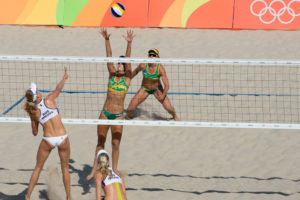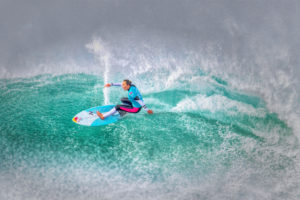
AI Takes the Stage at the Summer Olympics

CUE, the perfect free throw-shooting robot
It might not be obvious from the TV coverage, but the Tokyo 2020 Olympics (which of course are being held in 2021) are infused with big data and AI to an extent never before experienced in an Olympic games.
It’s been 53 years since the Olympics officially adopted electronic time-keeping equipment to track racers in Olympic events. Omega’s Magic Eye camera, which debuted in 1948, gave us the first of many “photo finishes” for track events, and was soon adopted in other events too.
Now the technology is going up a notch in the Tokyo 2020 Olympics (which perhaps should have been called the 2021 games), and Omega is behind much of it.
For example, Omega, which is the official timekeeper for 35 Olympic sports, is using cameras equipped with computer vision capabilities to track the movement of beach volleyball players, as well as the ball.
According to an article in Wired magazine, Omega has trained its AI to be able to identify a slew of different moves and shots, including smashes, spikes, blocks, and passes. This information is then combined with data gathered from gyroscopic sensors sewed into the players clothing, to give commentators real-time information on the exact movement of players and the ball.
“When you can track the ball, you will know where it was located and when it changed direction. And with the combination of the sensors on the athletes, the algorithm will then recognize the shot,” Alain Zobrist, head of Omega Timing, tells Wired. “So it’s this combination of both technologies that allows us to be accurate in the measurement of the data.”

Omega is using AI track the movement of beach volleyball players and the ball during the 2020 Olympics (Celso-Pupo/Shutterstock)
We are worlds away from the age of men with stopwatches timing races. In fact, you could say we have made a quantum leap from that time. At this event, Omega is employing the Quantum Timer, which is a form of atomic clock that uses laser-cooled single ions that are confined in an electromagnetic ion trap, according to a story in Digital Trends. (Okay, it’s not AI, but it’s still pretty cool.)
If you surf for fun, then big data is the last thing you want on your mind as you’re waiting for the next set. But surfing today is an extremely competitive sport–not to mention an Olympic sport for the first time–and the USA Surfing organization is employing plenty of big data techniques to help its athletes gain an edge.
The USA Surfing organization is also using big data techniques to gain an edge. According to an article in the Wall Street Journal, the group is using big data and AI in a variety of ways. At a physiological is tracking cardiovascular output, sleep patterns, heart-rate variability, and the frequency of certain injuries in a bid to improve the performance of its athletes.
The group has collected biomechanics data of its surfers using motion-capture cameras and sensors installed on a plate that’s a stand-in for a surfboard that detect how much force the athletes are expending. That is helping trainers fine-tune their training, and more carefully walk the line between generating “superhuman” abilities and an injury. It’s also taking a machine-learning approach with images of surfers’ stances on boards.

2020 (really 2021) Olympic Gold Medal surfer Carissa Moore of Hawaii shredding the gnar in South Africa in 2019
Machine learning also played a role in the site selection for the first surfing event in the Olympic Games. The WSJ’s Daniela Hernandez reports that Surfline, the popular surfing information website, pored through reams of data, including from satellites, ice cover sensors, bathometric measurements, wind pattern data, and buoy measurements, to come up with its recommendation for Tsurigasaki Surfing Beach.
Then there is the 3D Athlete Tracking (3DAT), the joint collaboration between Intel and Alibaba that takes computer vision to the next level.
According to this video from KGW News, 3DAT made its debute at the US Olympic Trials in Eugene, Oregon, and is being used in Tokyo. According to the video, the system takes imagery taken from five special trackside cameras, sends it to the Alibaba cloud, where deep learning algorithms fuse them and generate actionable insight, such as the top rate of speed for each racer.
According to Ashton Eaton, who’s a two-time Olympic gold medalist in the decathlon and who is also helping Intel develop 3DAT, the system has the potential to help close the performance gap for elite athletes.
“When I was running the 100-meter dash, I’d work with my coach to make adjustments to shave off fractions of a second, but it was all by feel,” he said in a March feature on the Intel website. “But 3DAT allows athletes to understand precisely what their body is doing while in motion, so they can precisely target where to make tweaks to get faster or better.”

Intel and Alibaba’s jointly developed 3DAT system makes its Olympic debut at the 2020 games (really 2021)
And then there are all the robots attending the Olympics. During the upcoming track-and-field event, viewers will see Toyota’s Field Support Robots (FSR) rolling across the turf to retrieve items like javelins. There is also the T-HR3 “humanoid robot,” also developed by Toyota, which will mirror the movements of their human owners from afar, as a sort of “avatar robot.”
And who could miss CUE, the basketball-playing robot that never misses a free throw (see the graphic at the top of the story)? With the U.S. men’s basketball team missing its final nine shots in its stunning loss to France in its opening game, perhaps CUE will be available to train the humans.
Related Items:
Five Real-World Applications for Sports Analytics
Deep Learning Is About to Revolutionize Sports Analytics. Here’s How
Big Data’s Next Big Thing: Sports Training and Personalized Medicine































